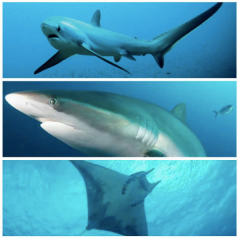
Great news from Johannesburg, South Africa, where this afternoon thirteen species were added to CITES (the Convention on International Trade in Endangered Species of Fauna and Flora). The new protection status of silky shark (Carcharhinus falciformis), three species of thresher shark (Alopias spp.), and nine species of devil rays (Mobula spp.) requires all participating countries to regulate the international trade of these species, thereby restricting their trafficking across borders, which will hopefully contribute to a decrease in fishing pressure driven by international trade demand.
Silky sharks and thresher sharks were proposed for listing because of estimated global declines of 70-90% due to the high demand for their fins. Silky shark fins are the second most common fin type in the Hong Kong retail market, which makes up more than 50 percent of the global fin trade. And devil rays need protection because they are facing global population declines due to growing, unregulated international trade in their gill plates, which are used for Chinese alternative medicine.
Despite repeated opposition to the listing from Japan, all three proposals to add sharks and rays to CITES were approved with a large majority in the Commission. The adoption of a resolution regarding Appendix I or II of CITES requires a majority of 2/3 of the votes. All countries now get six months to implement measures for threshers and devil rays, and a year for the silky shark.
The regulation of international trade in vulnerable shark species through CITES is a great victory for shark conservation, although trade remains just a single aspect of the bigger issue. Which is why it is still important that countries implement proper fisheries management and protective measures for declining shark populations.
The 17th meeting of the Conference of the Parties to CITES (CoP17) is taking place from 24 September to 5 October.





